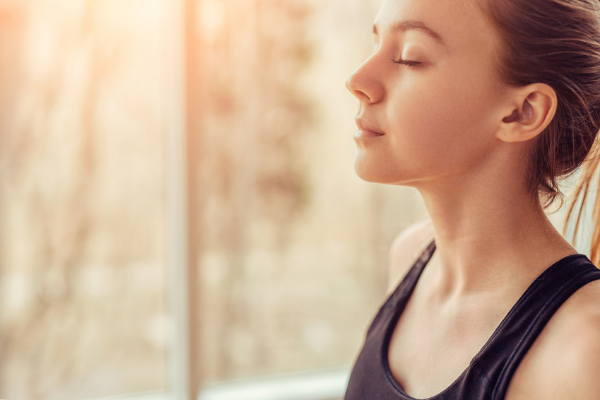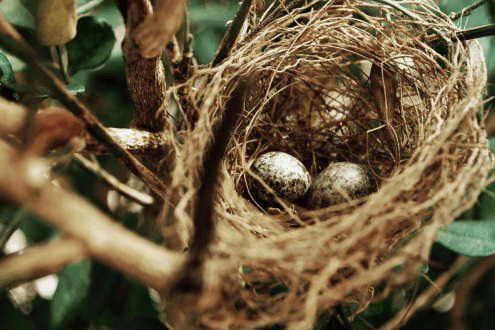How to breathe properly

Breathing is one of the most intuitive things we do, yet our breath has the potential for so much more than simply oxygenating our bodies. Yasmina Floyer discovers how to breathe properly to unlock its power focus, clarity and calm.
In my final year at university, I went for a job interview and was told I’d got the role before I left. My grades were excellent, I had an amazing boyfriend (now my husband) and a great group of friends. I made my way to the bus stop basking in a sky rinsed clear by the summer sun. And then I couldn’t breathe.
Panic snatched the air from my lungs and I existed only as feelings: in the heartbeat knocking out a syncopated rhythm in my throat, in the aching tightness in my jaw and in my chest. I felt like I was drowning on dry land. It lasted no more than a minute. I was tired, I reasoned with myself. Dehydrated. I didn’t know it at the time, but I had just had my first panic attack. Since then, anxiety and panic have been constant companions.
The inextricable link between our mental and emotional wellbeing and our bodies is something I understand too well. ‘When we become stressed or anxious, our brain signals for the sympathetic nervous system to fire up the fight/flight response to help us attend to the threat,’ health psychologist and psychotherapist Dr Sula Windgassen tells me.
‘The impact of this can be physically noticeable, for example, we may find our palms
sweating, our mouth going dry, or the need to urgently go to the toilet. A consistent effect of stress is an increased heart rate and shallow “chest breathing”, so that we inhale less oxygen.’
The period before lockdown and beyond saw me experience some of the worst panic attacks of my life. Waking up when you have severe anxiety is like having a bucket of ice-cold water thrown on you. There is a split second between sleep and cold dread.
For me, appetite was replaced with fear, and my stomach was filled with it, leaving little room for food. Try a biscuit dipped in tea, take small bites, the kind voice on the anxiety helpline said when I would call in tears having failed to leave my bed. At times, I would sit and stare at the wall for hours, attempting to muster the mental energy to appear normal when my kids returned from school.
The voices on helplines became harder to listen to over a noisy mind weaving a tapestry of catastrophe. I began to lose hope I would ever feel like myself again, and could not fathom a life where each day would be this painful to get through.
I found that I kept returning to the idea that breathing can create an extreme shift in the way we perceive and experience events in our lives. It was a message cropping up everywhere, from the documentary on ‘The Iceman’, Wim Hof, I watched with my husband, to my yoga teacher reminding me of its connection to our life force. When I heard Olympian Tom Daley on Fearne Cotton’s Happy Place podcast speak of advice given to him by his diving hero, Greg Louganis – ‘fear is just excitement without breathing’ – I knew exploring breathwork was no longer something that I could ignore. I wanted to learn how to breathe properly to find focus and calm.
Around this time, with my mental health in a particularly bleak place, I connected with freediver and breath trainer Helena Bourdillon. When I learned of how she overcame her own battle with chronic depression and went on to become a record-holding freediver representing Great Britain in four world championships, I saw her as a beacon of hope.
Bourdillon first experienced low feelings aged 12 and, as she got older, the periods of depression increased and the gaps between them shortened.
She knew something wasn’t right following a holiday, at the age of 26: ‘I rang my doctor and said I thought I might be depressed. It was the first time I had ever used that word or even thought about it.’
Self-harm and suicidal thoughts soon followed. It was during a meditation session that the isolation blinkers of depression were removed, says Bourdillon: ‘It made me realise I wasn’t alone. I found a connection with people in a similar situation, which was hugely powerful.’
That ability to connect with herself and be present is what drew her to freediving: ‘It was love at first dive. I was completely absorbed in the water, in the moment. I was so present, and I wasn’t haunted by anything from my past, or by anxiety about my future. I felt so at peace.’
That freediving requires the ability to fight panic and hold your breath for prolonged periods of time led Bourdillon towards breathwork.
She says: ‘Breathwork is bringing your awareness into your body, which helps us heal. The more you can pay attention to your breathing in the day, the more you can affect your mood.’
Dr Windgassen tells me more, explaining how breathwork does this by activating the soothing parasympathetic nervous system, via the vagus nerve. ‘Its job is to bring the body back to equilibrium once the threat or stressor has gone,’ she adds. ‘It is referred to as the “rest and digest” arm of the nervous system, and helps to calm the body back down, flushing out stress hormones and returning the heart rate to normal.’
I meet Bourdillon for a breathwork session.
‘The thing about breathing is that everyone takes it for granted,’ she says, adding that the majority of people aren’t breathing properly: most people are using their mouths to breathe, when they should be nose breathing in the vast majority of circumstances.
She tells me to place one hand on my chest, the other on my belly, to breathe in for a count of four and out to a count of six, making sure that the volume of breath is equal for both inhale an exhale. The aim is to keep the top hand from moving, to encourage the breath lower.
I close my eyes, take a breath. After a few cycles I notice birdsong and feel like I’m at the centre of that sound. I am not able to do this while keeping my chest completely still, however.
‘Practise,’ Bourdillon tells me, ‘It gets easier.’
The key to breathwork, and maintaining our mental health in general, is that self-care ought to be practised all the time, not just in moments of crisis.
‘The trouble is that when you’re in a panic attack and in anxiety, the chances of you going “Oh, let’s have a look at my breathing” are pretty much zero,’ Bourdillon says. ‘The key is to practise it when you’re calm.’
Dr Windgassen agrees: ‘The more we do it, the more access we have to it as a resource in times of need.’
My breathwork was put to a challenge only last week. It was lunchtime and I had gone down to the kitchen to make tea. The cold tiles absorbed the heat from my feet and I felt the familiar, inexorable wave of panic rising. Oh God, I thought, and knelt on the tiles. Usually when this happens I lose capacity for logical thought and my senses take over. I felt my arms go numb. I was on the edge of hyperventilating.
I have failed, I thought; I am writing about how breathwork can help us and I am about to have a panic attack.
But, then, I paused. I placed one hand on my chest and the other on my stomach and focused on keeping my top hand still. I focused on the counts, making my exhale longer. My breath sounded like the ebb and fl ow of a tide. I don’t know how long I sat there for, but when I opened my eyes again, I was breathing normally, and I realised that
I hadn’t failed at all.
4 techniques for how to breathe properly
There is no single way for you to learn how to breathe properly. Try these different techniques for using your breath more effectively and see which works best for you.
4/6 breathing
To ease a fractious mind into peaceful sleep, Bourdillon advises practising 4/6 breathing at bedtime, for 10 minutes, inhaling for four counts and exhaling for
six. The volume of breath from the exhale should be the same as the inhale.
Box breathing
Dr Windgassen says: ‘Box breathing involves imagining breathing around four sides of a box. You breathe in for 4-6 seconds, hold for 4-6 seconds, out for 4-6 seconds, hold for the same time, and go back around the box again.
In terms of repetition of the breathing techniques, there is no gold standard. Using these methods as a momentary break in stress can mean using them for as little as two to three rounds.
In other instances, you may wish to do it for longer. The important thing is to establish some kind of consistent practice that works for you.’
Nose breathing
Bourdillon explains that aside from the physical benefits of avoiding mouth breathing, breathing through the nose helps to bring an awareness, and says ‘it’s awareness in the body that actually helps us heal.
The more you can pay attention to your breathing in the day, the more you can affect your mood.’
Belly breathing
To create calm in acute moments of stress – for example, before a presentation – Dr Windgassen recommends belly breathing (diaphragmatic breathing). Take intentional deep breaths, usually in through the nose if you are able to, pulling the breath deep down into the lungs, allowing the diaphragm to expand on the in-breath.
The belly will visibly grow as the diaphragm contracts, moving downwards, creating more space in the chest cavity for the lungs to expand, pushing out the stomach.









